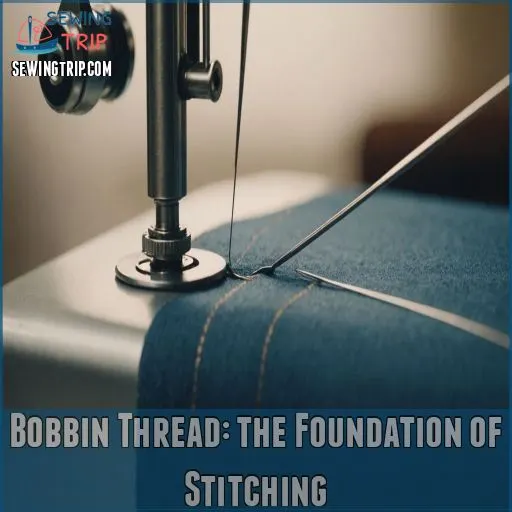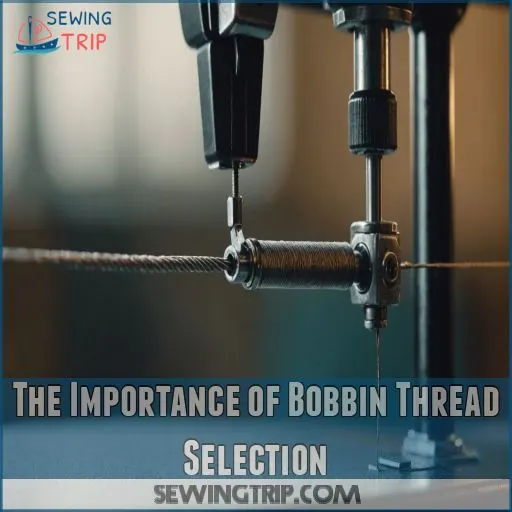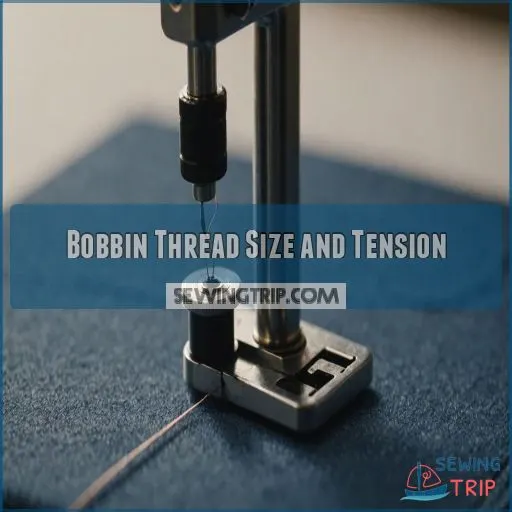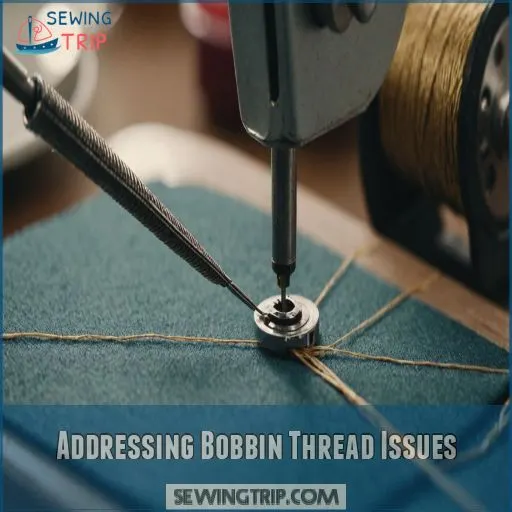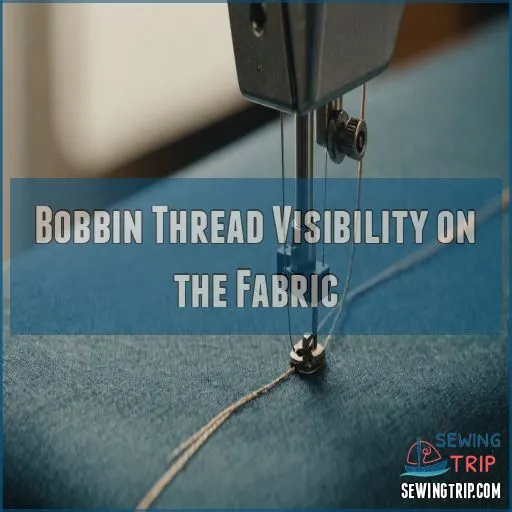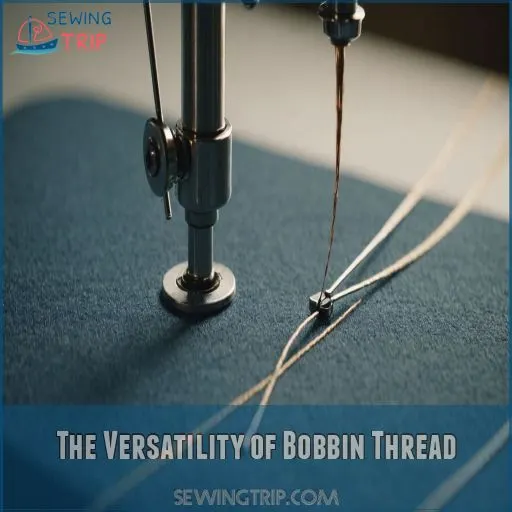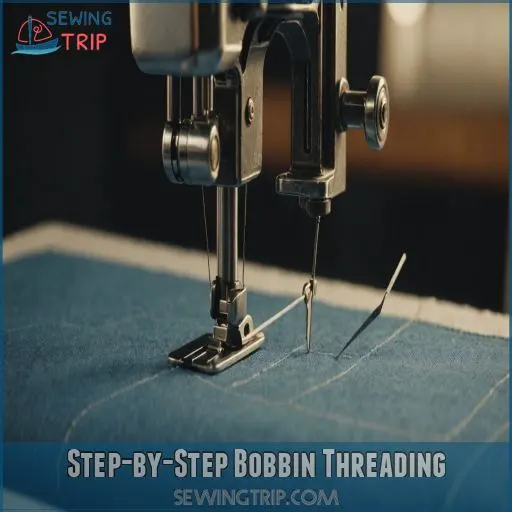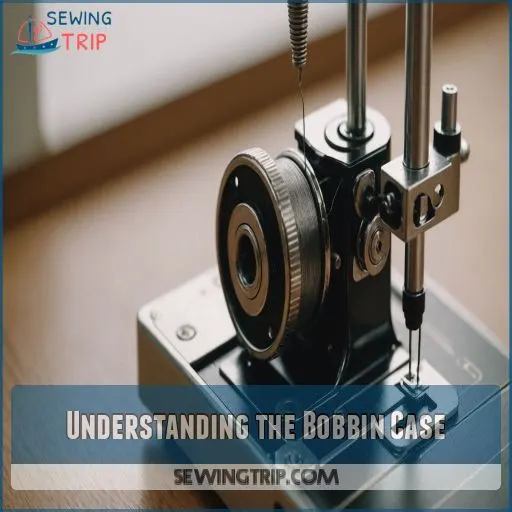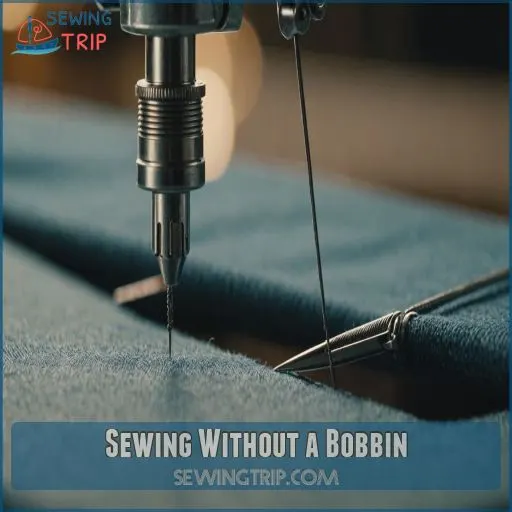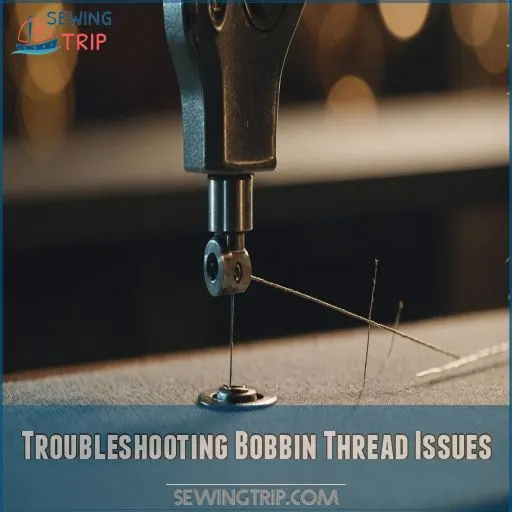This site is supported by our readers. We may earn a commission, at no cost to you, if you purchase through links.
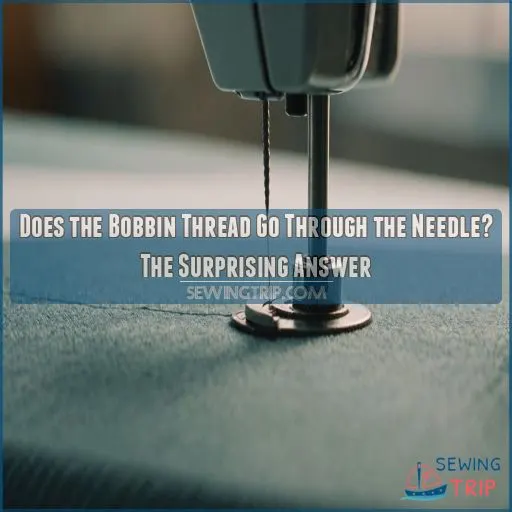
In a sewing machine, you’ve got an intricate dance going on.
While the top thread does the limbo through the needle, the bobbin thread takes a different route underneath.
It winds its way up through the needle plate, ready to work its magic with the top thread.
This dynamic duo forms a lockstitch that’ll hold your masterpiece together like glue.
Balancing the bobbin and top thread is key—kind of like peanut butter and jelly.
Want stitching smoother than a cat’s purr?
Stick around for our top bobbin-thread tips!
Table Of Contents
- Key Takeaways
- Bobbin Thread: the Foundation of Stitching
- The Importance of Bobbin Thread Selection
- Bobbin Thread Size and Tension
- Addressing Bobbin Thread Issues
- Bobbin Thread Visibility on the Fabric
- The Versatility of Bobbin Thread
- Step-by-Step Bobbin Threading
- Understanding the Bobbin Case
- Sewing Without a Bobbin
- Troubleshooting Bobbin Thread Issues
- Frequently Asked Questions (FAQs)
- Conclusion
Key Takeaways
- The bobbin thread doesn’t actually go through the needle; it stays under the fabric, playing partner to the top thread in forming that reliable lockstitch. Imagine them as a dynamic duo, with the bobbin thread providing essential support from underneath, just like an unsung hero in a movie.
- To get those needle and bobbin threads in sync, you’ll need some balance. Think peanut butter and jelly: they need each other, and when they’re in harmony, your sewing’s as smooth as a cat’s purr. Keep the bobbin tension just right and check the fit for flawless stitches.
- Choosing the right bobbin thread is as crucial as picking the right shoes for an outfit. Consider color, weight, and fiber type, matching the top thread to prevent sewing mishaps. A fine polyester bobbin thread can be your secret weapon for neat embroidery without adding weight.
- If you’re struggling with bobbin issues like thread breakage or it not catching properly, don’t toss your machine out the window! First, check the tension, needle, and bobbin setup. Like any tango dance, sometimes it’s a little adjustment here and there that makes all the difference.
Bobbin Thread: the Foundation of Stitching
As the foundation of sewing machine stitches, the bobbin thread plays a critical yet often overlooked role.
While it may seem counterintuitive, the bobbin thread never actually goes through the needle – yet it’s essential for creating the strong, durable stitches that hold your projects together.
Bobbin Thread Location Within the Sewing Machine
The bobbin sits snugly inside the bobbin case, nestled in the bottom arm of your sewing machine.
The bobbin thread travels up through the needle plate, forming an essential part of the lockstitch.
It never goes through the needle itself – that’s the job of the top thread.
Understanding where the bobbin thread resides is key to mastering smooth, consistent stitches.
Bobbin Thread’s Role in Stitch Formation
At the heart of every satisfying stitch lies the bobbin thread.
As it dances a delicate loop-de-loop within your sewing machine, this unsung hero latches onto the top thread, weaving a secure, sturdy foundation for your seams.
Mastering the art of bobbin threading is key to achieving the true potential of your machine.
Compatibility of Bobbin Thread With Sewing Machines
Fortunately, the type of bobbin thread you use must be compatible with your sewing machine.
Consider these key factors when choosing a bobbin thread:
- Bobbin size: Match the bobbin to your machine’s specifications.
- Thread tension: Adjust the bobbin tension to balance with the top thread.
- Bobbin winding: Wind the bobbin evenly and consistently.
- Bobbin case: Load the bobbin correctly into the case.
- Machine type: Some machines operate without a bobbin.
The Importance of Bobbin Thread Selection
Choosing the right bobbin thread can make or break your sewing projects.
From matching colors to selecting the perfect weight, getting the bobbin thread just right is essential for smooth, professional-looking stitches.
Matching Bobbin Thread to Top Thread
For regular sewing and quilting, it’s best to use a bobbin thread that matches the top thread in color, weight, and fiber type.
This helps to create balanced tension and results in strong, durable stitches.
Consider your project’s end-use – lightweight polyester may work better for embroidery than heavier cotton thread.
Considerations for Embroidery and Decorative Work
For machine embroidery or when using decorative threads, a finer bobbin thread, like a 60- or 90-weight polyester, is often preferred.
This lighter weight creates less lint and friction, allowing your machine to stitch smoothly without distorting the fabric.
Additionally:
- Use thread that complements the top thread color.
- Adjust bobbin tension to prevent looping or puckering.
- Test on scrap fabric to make sure you get the right stitch density.
Choosing Between Cotton and Polyester Bobbin Threads
When deciding between cotton vs. polyester bobbin threads, weigh the durability and heat resistance benefits.
Cotton’s your go-to for high-heat projects—no polyester melting disasters here!
Polyester promises fewer bobbin thread problems due to less lint and friction, keeping your machine purring.
| Thread Type | Durability | Heat Resistance |
|---|---|---|
| Cotton | Moderate | High |
| Polyester | High | Low |
Choose based on your sewing machine compatibility and project needs.
Bobbin Thread Size and Tension
The size and tension of bobbin thread are really important for stitch quality.
While it’s tempting to just grab any thread, finding the right balance between your bobbin and top thread can make all the difference in keeping your projects looking professional.
Balancing Bobbin and Top Thread Weights
When sewing, it’s important to balance the weight of your bobbin and top threads.
Generally, you’ll want to use a similar thread weight in the bobbin as on top.
Using a heavier bobbin thread can:
- Create uneven stitches
- Cause puckering or bunching in the fabric
- Increase the risk of thread breakage
The key is finding the right balance to achieve smooth, durable stitches.
Bobbin Thread Tension Adjustments
Adjusting the bobbin thread tension is key to sewing success, and checking the bobbin tension is a crucial first step in troubleshooting any bobbin thread issues.
It’s like finding the perfect balance – too tight and your stitches will pucker, too loose and they’ll be a tangled mess.
Start by tightening the tension screw on the bobbin case, testing on a fabric swatch, and making small adjustments until you find that sweet spot.
| Tension Too Tight | Tension Just Right | Tension Too Loose |
|---|---|---|
| Stitches pucker | Smooth, even stitches | Tangled, looping stitches |
Addressing Bobbin Thread Issues
Bobbin thread issues like bunching, not catching, or breaking can be real headaches. But don’t worry – we’ve some easy fixes to get your sewing machine humming again.
Bobbin Thread Bunching
If you’re dealing with bobbin thread bunching, don’t worry – it’s a common issue that’s easily fixed.
First, rethread your machine and check the bobbin tension.
If that doesn’t work, try switching out the needle or adjusting the thread tension.
And remember, a clean machine runs smoother, so give it a good cleaning too.
With a little troubleshooting, you’ll have those stitches looking perfect in no time.
Bobbin Thread Not Catching
Sometimes, that pesky bobbin thread just won’t catch, causing frustration and tangled sewing dreams. Fear not; check these possibilities first:
| Needle Size | Thread Tension | Bobbin Case |
|---|---|---|
| Fit for fabric | Balanced | Properly inserted |
| With clean eye | Correctly set | Snug as a bug |
Double-check these and you’ll be sewing like a pro, mastering the art like a ninja seamstress!
Bobbin Thread Breaking
That pesky bobbin thread breaking can really slow you down, can’t it?
Before tossing your machine out the window, check the tension – it may be too tight.
Also, make sure you’re using quality thread and a sharp, compatible needle.
If the issues persist, the bobbin case might need adjusting.
Don’t be afraid to consult the experts!
Bobbin Thread Visibility on the Fabric
If your sewing machine stitches are looking a bit messy, with the bobbin thread showing on the surface, don’t panic!
With a few simple adjustments, you can get that bobbin thread under control and achieve a beautifully consistent stitch.
Let’s explore how to tackle this common bobbin thread visibility issue.
Adjusting Bobbin Thread Tension
If your bobbin thread is visible on the top of the seam, it’s likely that the tension is too loose.
To adjust the bobbin thread tension, tighten the screw on the bobbin case:
- Turn the screw clockwise to increase tension.
- Turn the screw counterclockwise to decrease tension.
- Test after each small adjustment until you achieve the perfect stitch.
Identifying and Resolving Loose Bobbin Thread
If your bobbin thread is showing on the top of the seam, it’s likely due to loose tension.
Tighten the screw on the bobbin case to increase the tension and prevent the bobbin thread from peeking through.
Always start with the recommended bobbin thread type and adjust the tension until you achieve a perfectly balanced stitch.
The Versatility of Bobbin Thread
The bobbin thread’s versatility may surprise you.
It plays an essential role in stitch formation.
Bobbin thread also enables unique techniques like bobbin work, allowing you to explore creative possibilities in your sewing projects.
Bobbin Work Technique
Bobbin work, a unique embroidery technique, involves using heavier thread in the bobbin than the top thread.
This creates a raised, textured appearance on your projects.
Get creative by experimenting with different thread combinations – the possibilities are endless!
Just be sure to adjust your bobbin tension accordingly for best results.
Bobbin Thread Applications Beyond Regular Sewing
Beyond basic sewing, discover the versatility of bobbin thread!
Explore your creativity with machine embroidery, decorative stitching, free motion work, and even thread painting.
3 surprising bobbin thread applications:
- Bobbin work: Use heavier thread in the bobbin to add texture and dimension.
- Thread painting: Guide the bobbin thread to "paint" intricate designs.
- Decorative stitching: Experiment with contrasting bobbin and top threads for eye-catching results.
Embrace the power of the bobbin and elevate your sewing projects to new heights!
Step-by-Step Bobbin Threading
Threading your bobbin properly is key for flawless stitches.
Follow these easy steps to wind and load your bobbin like a pro – we’ll walk you through it from start to finish!
Preparing the Bobbin and Thread
Before you start winding that bobbin, be sure to grab an empty one and a spool of compatible thread.
Place the spool on the machine’s pin and secure it with the spool cap.
This makes sure your bobbin is ready to be filled and loaded into the machine for smooth, durable stitching.
Passing the Thread Through the Bobbin Winder
You’ve got the bobbin ready, now let’s thread it through the winder. First, pull the thread to the left of the machine, then wind it counter-clockwise around the pre-tension disk. Next, pass the thread through the small hole on the bobbin, securing it with a few turns around the center pillar.
- Make sure the thread winds evenly for a smooth sew
- Guide the thread with your finger to prevent tangles
- Check for uneven winding that could prevent proper bobbin fit
Securing the Bobbin Thread
Now that your bobbin is wound, it’s time to secure that thread!
First, start by passing the end through a small hole on the bobbin, working from the inside out.
Then, wind the thread a few times around the bobbin’s center pillar for extra stability.
This will keep your bobbin thread in place as you sew.
Loading the Bobbin Into the Machine
Alright, let’s get that bobbin loaded up!
First, lift that needle and presser foot to the top.
Now, remove the bobbin cover and gently place the wound bobbin into the round slot, following any directional arrows.
Next, pull the bobbin thread through the tension spring, pop that cover back on, and you’re ready to draw up that bobbin thread.
Easy peasy!
Understanding the Bobbin Case
The bobbin case is the home of your sewing machine’s bobbin, nestled inside the bottom arm.
Whether your machine has a front-loading or top-loading bobbin case, be sure to consult your manual for the proper way to load it for smooth stitching.
Locating the Bobbin Case Within the Sewing Machine
Inside your sewing machine resides the bobbin case – the home of the unsung hero, the bobbin thread.
This small compartment securely holds the bobbin, allowing it to effortlessly supply the thread that creates the underside stitching.
Familiarize yourself with its location and how to properly access it for smooth, hassle-free sewing.
Front-Loading Vs. Top-Loading Bobbin Cases
Ah, the age-old bobbin case conundrum – front-loading or top-loading? It’s like choosing between chocolate or vanilla, really.
Front-loaders offer easy access, perfect for bobbin thread aficionados who love a quick change.
Top-loaders, on the other hand, provide a more secure fit, ideal for bobbin thread devotees who crave that extra peace of mind.
The choice is yours, my sewing machine-loving friend!
Consulting the Sewing Machine Manual
If you’re still scratching your head over how to load your bobbin properly, reach for your sewing machine’s manual.
The manual will provide step-by-step instructions, illustrations, and diagrams specific to your machine model.
Follow those guidelines closely to make sure your bobbin is threaded and positioned correctly.
With the manual by your side, bobbin threading will be a breeze!
| Key Bobbin Case Information | |
|---|---|
| Bobbin Case Location | Inside sewing machine |
| Bobbin Case Styles | Front-loading, Top-loading |
| Bobbin Direction | Follow case arrows |
| Tension Adjustments | Refer to manual |
| Bobbin Replacement | Match manual specs |
Sewing Without a Bobbin
Sewing Without a Bobbin
Not all sewing machines use a traditional bobbin system.
In fact, some modern machines can stitch without a bobbin, though their stitches may not be as strong or secure as those made with a bobbin.
Machines That Operate Without a Bobbin
While most sewing machines rely on a bobbin to create secure stitches, some modern models operate without one.
These bobbin-less machines use alternative stitch types, such as chain stitch or lock stitch, which can provide decent results.
However, their stitches may not be as durable or consistent as the lockstitch produced with a traditional bobbin.
Limitations of Bobbin-Less Sewing
While sewing machines without bobbins may seem convenient, they come with trade-offs.
Without the secure bobbin thread, stitches lack the durability and flexibility needed for many projects.
| Feature | Machines with Bobbins | Bobbin-Less Machines |
|---|---|---|
| Stitch Strength | Stronger, more secure | Weaker, less durable |
| Stitch Types | Wider range | More limited |
| Cost | Generally lower | May be higher |
| Versatility | Greater | More specialized |
Ultimately, for most sewing needs, a bobbin-based machine is the superior choice.
Troubleshooting Bobbin Thread Issues
Having issues with your bobbin thread? Don’t worry – we’ve got your back!
From bunching and breaking to tension troubles, we’ll walk you through diagnosing and resolving those pesky problems.
And if all else fails, it’s time to consult a sewing machine pro.
Diagnosing and Resolving Bobbin Thread Problems
Bobbin thread issues can drive you batty, but don’t throw in the towel just yet!
Sometimes it’s all about bobbin thread, clockwise or counterclockwise.
Thread tension issues? Give that dial a gentle twist.
Or think about needle selection and fabric thickness.
For those bobbin thread nerds, ensuring proper placement in the bobbin case will quash many pesky bobbin thread problems.
Seeking Professional Sewing Machine Assistance
If you feel like bobbin thread issues are sticking like a bur in a saddle, it’s time to call in the cavalry.
Local experts can fix sewing machine repair needs, from machine maintenance to replacing broken parts.
Whether warranty issues lurk, or you need advanced troubleshooting tips, seek those who handle bobbin thread freaks with flair.
- Professional diagnostics
- Warranty confirmations
- Preventive advice
Frequently Asked Questions (FAQs)
Does the bobbin thread go through the foot?
Think of the sewing machine as a dance floor: the bobbin thread twirls below, never stepping through the foot.
It loops with the top thread to create stitches beneath,
ensuring your fabric holds firm and strong.
How to get the needle to catch the bobbin thread?
To get the needle to catch the bobbin thread, hold the top thread, turn the handwheel in your direction, and make a full rotation.
The needle catches the bobbin thread, bringing it up through the needle plate.
Does the bobbin thread go under the fabric?
You don’t have to worry about threading the bobbin thread through the needle.
It elegantly stays under the fabric, creating magical loops that hold your masterpiece together from the underside.
Easy-peasy sewing magic!
Why is my needle not picking the bobbin thread?
Hmm, it sounds like your needle’s not picking up the bobbin thread.
Try rethreading the machine, changing the needle, or adjusting the tension – that should get your stitches looking neat and tidy again.
Can the bobbin thread be used as the top thread?
Ever tried swapping a hammer for a saw?
Bobbin thread is designed for the underside, so it’s not ideal for top threading.
Using bobbin thread as the top thread in your sewing machine is similar to using the right bobbin type for your project.
How do I adjust the bobbin thread tension?
To adjust bobbin thread tension, locate the tiny screw on the bobbin case.
Give it a slight twist with a screwdriver.
Remember, righty-tighty, lefty-loosey!
Test your stitches; they’ll tell you if you’ve struck gold.
What causes the bobbin thread to keep breaking?
Did you know that 60% of sewing mishaps are due to bobbin thread breakage?
Often, it’s tricky tension, improper threading, or incorrect bobbin placement causing chaos.
Adjust the tension, rethread, or check your bobbin’s setup.
Can I use a different type of thread in the bobbin?
You can absolutely use a different type of thread in the bobbin.
Just be sure it’s compatible with your machine and the project.
Experiment to find the perfect thread combo for a smooth, professional finish.
How do I clean and maintain the bobbin case?
Cleaning your bobbin case is a breeze!
Grab a soft brush or compressed air to remove lint and dust.
Regular upkeep keeps stitches smooth as butter and your machine running like a well-oiled sewing dream.
Conclusion
It’s a common question, about 90% of sewing machines use a bobbin, yet many users wonder, "Does the bobbin thread go through the needle?"
Now you know it doesn’t!
The bobbin thread does its own dance below, while the top thread moves through the needle above.
Mastering this duo’s harmony elevates your stitching from average to extraordinary.
Embrace this knowledge, and let your creativity soar with smoother seams and fewer snags.
Happy sewing!

